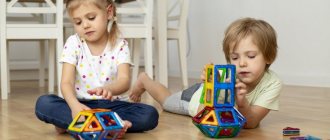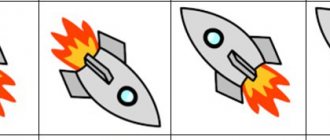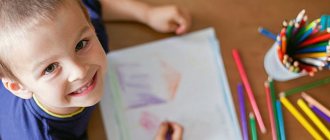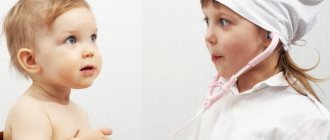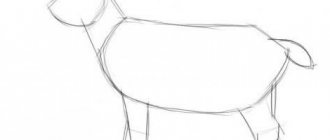Primary school teachers are well aware that young students come to school with completely different levels of preparation. And the better it is, the more confident the child feels in class, and the faster and easier the material is learned. However, you won’t be able to prepare well for school quickly. Even from kindergarten, with the help of games, it is necessary to develop the thinking processes of children, and later, through developmental activities with children already 4-5 years old, you can master the basics of literacy and mathematics.
Any parent can handle the preparation of a future schoolchild; the main thing is to know what knowledge and skills to teach at 4-5 years old, and how to turn home schooling into a “system.”
Age characteristics of a child 4-5 years old
4-5 years is one of the favorable periods in a child’s life for learning new knowledge and skills. All this is possible thanks to a sufficient level of emotional and physical development. The main features of development at 4-5 years old:
- The child learned to think figuratively and imagine. Can find something similar to a given object, selects one from several by size, color, shape and other parameters.
- Voluntary memory develops: the baby is already able to learn a poem and remember the instructions given to him. Figurative and verbal memory is formed.
- The time to concentrate increases. Now a preschooler can be occupied with one activity for 20 minutes.
- Motor skills are improved. Coordination, balance, and motor skills (both large and fine) improve.
- The drawings become more detailed, the preschooler is already given the opportunity to glue, cut out, and design according to a model and his own imagination.
- Speech becomes richer. Diction and pronunciation of sounds improves. The child easily imitates most sounds and speaks with intonation. The cognitive motive, the so-called “why mode,” is activated. A preschooler strives to master new knowledge; adults should help him with this.
- The central form of development is play activity. Now role-playing games dominate. Therefore, it is recommended to base all classes on games.
What have I done for myself?
The application of the Montessori method begins not with the child, but with the parents. To understand how to develop a child at 4.5 years old and create a favorable environment at home, you first need to work on yourself. Because a parent who is not a resource is not capable of much.
Previously, every free 5 minutes I was distracted by chats that had nothing to do with my development. Now the realization has come that this is an empty exercise that takes a lot of time. But it can be spent usefully: loading the dishwasher and washing machine, clearing the table, hanging laundry, vacuuming, watching children, writing down your thoughts.
If the children see me just sitting and drinking tea, they will drop what they are doing and come running. The same thing will happen if I lie down. Therefore, it is wisest to devote time to the home, and at the same time involve the children. It's no more difficult than chatting, but it's so useful.
Here are a few other small achievements that have significantly improved the quality of my life:
- During the course, I became acquainted with the graph of emotions and each of them separately. Now I can control myself better; this is a valuable skill when communicating with children.
- I learned to find time for myself. At least once a week, my husband and I go out on business or for a walk, and leave the children with their grandmother - they are already old enough. After three such weeks, I learned to concentrate on myself and get proper rest.
- I communicate with Montessori mothers in the alumni chat. We discuss what new things we have learned, what books we have read - and so we develop together. This is my point of interest and source of inspiration.
I learned the habit of not cleaning when the children are asleep immediately after the birth of my daughter. At such moments I sleep, watch webinars, films. I start “my” time with a cup of coffee, something tasty and a languid look out the window.
I want the children to see their mother happy and beautiful. The hardest thing was to realize that I was the main part of the developing environment for children. I created conditions under which it became easier for children to develop and explore the world, but I forgot about myself: this applied to both internal and external resources. Even my husband began to be indignant that I spend the money he gives me on children. I began to change and allow myself what I had denied for a long time. Whether it's cakes, a new shampoo, a trip to a beauty salon or cafe, a walk.
Developing speech
Here are some simple but effective exercises that you can do at any time:
- “What happens...” Tell your child the characteristics of an object and ask what happens with such characteristics. Gradually, the task can be complicated by combining several characteristics at the same time.
- “What happens if...” Come up with any plot situations and wonder what will happen in this case.
- "What can be done…". Any object is taken and the question is asked what can be done with it. You can also ask what not to do and why.
- "What and where." Ask your child basic questions. For example, where is the frying pan or TV. Ask to describe all items from any room in as much detail as possible.
- Describe any animal to your baby and ask him to guess. Change roles: let the child try to act as a mystery teller.
- Play onomatopoeia. Pay more attention to problem sounds (usually s, sh, z and r).
IMPORTANT! Be sure to learn poems, songs, fairy tales, and read a lot. Discuss what you saw and heard. The development process must be continuous.
Also read about toys for children's speech development.
Games to develop logical thinking
Logical skills are well used in the following exercises:
- Generalize objects according to any characteristic (for example, find everything round, flat, yellow).
- Determine the similarities and differences between pictures or individual objects.
- Select identical objects from many.
- Assemble the constructor according to the sample.
- Find an extra item and explain your choice.
- Select paired objects, name the characteristic by which the choice was made.
- Find a way out of the maze. Such tasks are found in all children's magazines and educational publications).
Memory is not only visual
It is human nature to remember what he sees, hears and does. Therefore, memory development should be aimed at all of these aspects.
- Visual memory is well trained by looking at pictures with their subsequent description, as well as remembering the location of objects in the room. You can ask your child what he was wearing yesterday. Develops visual memory by playing to rearrange toys: several objects are placed, and when the child turns away, they are swapped. The preschooler's task is to guess what has changed.
- Auditory memory is trained by learning nursery rhymes and rhymes. It is advisable to learn four lines a day. It is imperative to retell fairy tales and share impressions of what you saw, and everything needs to be told in detail. You can also give your child play tasks: buy in a “store” according to an oral list or set the table according to certain instructions, also spoken orally.
- Motor memory is trained during games in which you need to repeat the movements of adults. Once a certain game is learned, an adult can “accidentally” make a mistake; the child’s task is to find and correct the mistake.
Interesting drawing lessons
Children of senior preschool age love to draw. They already have skills in handling brushes and paints, felt-tip pens, and pencils. Drawing develops speech, fine motor skills, imagination, perseverance, and attentiveness.
To teach your child to depict various objects, you can use the following methods:
- tracing figures with a dotted outline. The child will remember the shapes of different objects;
- use of coloring books;
- carbon copy drawing (outlining already prepared images and then coloring them).
When teaching a child to draw, you need to use simple lines and geometric shapes. There are many interesting lessons.
Master class on depicting a deciduous tree:
- draw a tubercle at the bottom of the sheet;
- above it (at the top of the paper) draw a circle;
- connect two objects with straight lines (this is a trunk);
- draw branches;
- give the edge of the crown unevenness (highlight those places where the branches enter);
- Draw grass on the hillock.
Development of attention
In order for a preschooler to be able to easily switch from one type of activity to another, concentrate his attention on work for a long time and not get tired, attention also needs to be regularly developed.
Game options:
- Find changes in the appearance of the adult and in the arrangement of objects.
- All kinds of variations of the game “edible-inedible” (shoes are not shoes, speaks - does not speak).
- Find the differences in two pictures.
- Game "Trailers". The mother names the object, the child repeats and adds his own, the mother now repeats two objects and adds a third. And so on until someone makes a mistake.
- While walking near the house, you need to remember as many details as possible, and the next day discuss what has changed in the environment.
- With your eyes closed, describe what and exactly where it is in the room.
Reading and writing
By the fifth year of life, a child already needs to train his hand for further writing at school. The same goes for reading. Simple rules will help with this. These benefits will help develop the child’s hand muscles and prepare them for further writing. You need to start with the simplest elements - tracing patterns and connecting dots. And only after that you can move on to independent writing.
The perception of the first sound in a word is necessarily worked out. To do this, you can glue letters to any objects in the house. The child’s task is to guess whether the card with the letter is chosen correctly.
REFERENCE! In this matter, Zhukova’s primer will be a good assistant for parents. It describes in detail the sound fusion algorithm and other recommendations for adults.
LEARNING MATHEMATICS
The first thing that comes to mind here is numeracy skills. Because it is still difficult for a child to master calculations. How to teach a preschooler to count?
A child can understand how a specific number relates to the designated number, for example, using counting sticks or cards that depict the number and various objects in the corresponding quantity.
To reinforce counting in order, you can use coloring pages that require you to connect numbered dots.
Also, the consolidation of ordinal counting is facilitated by the constant recounting of surrounding objects: houses, benches, birds, steps on the stairs, apples in a vase.
Mathematics is also geometry. By this age, the child should already know basic geometric shapes. Now it is important to consolidate this knowledge, as well as develop the preschooler’s thinking by playing interesting games with figures. For example, you can fold triangles into rectangles, squares, rhombuses, and other triangles. You can make rectangles from squares.
It is also interesting for children at this age to draw using geometric shapes (everyone knows that a triangle is a skirt, a circle is a sun, a triangle with a rectangle is a house). Also, the child can already compare figures by color, shape, size.
Musicality, sensory and movement
Any preschooler needs to move a lot. Movement helps strengthen the skeleton and muscles, improves agility, coordination, and endurance. Therefore, a child’s life should include gymnastics, exercises, dancing, any outdoor games, as well as cycling.
If you accompany physical exercises with music, this will promote the development of musicality. To develop a preschooler’s sensory perception, he needs to be given the opportunity to touch various textures and materials.
It is necessary to strive to improve fine motor skills, which will improve speech, thinking, logic and memory. Any games with small objects, including finger games, are well suited.
Speech therapy lesson plan
By the age of five, children should fully master the system of their native language: speak coherently, express their thoughts clearly, construct complex sentences, retell fairy tales, pronounce all sounds correctly.
If a child has speech impairments, he will make mistakes in the lexical-grammatical, phonetic-phonemic structure. These children have a limited vocabulary and cannot form complex or simple sentences. Babies' speech may be incoherent.
There are many reasons for deviations:
- memory impairment, absent-mindedness;
- weakness of the muscles of the articulatory organs;
- problems with fine motor skills;
- unformed verbal-logical, visual-figurative thinking.
To solve speech problems, speech therapy sessions are conducted. The lesson program should be developed by a specialist. Parents can do simple exercises at home.
Conditions for correcting the phonetic-phonemic system:
- compliance by family members with stylistic, spelling and grammatical forms when using speech;
- creation of a complete speech environment. Parents should communicate a lot and often with each other in the presence of the child;
- development of auditory function;
- encouraging children to imitate the object and speech actions of adults.
Parents are able to help children enrich their vocabulary, master the correct grammatical structure of speech, and improve their sound culture.
Speech therapy classes should take into account the following rules:
- regularity;
- perform exercises in a playful way to interest the child;
- Praise your child for his achievements. Don't scold him if he shows bad results.
To improve speech, finger games and articulatory gymnastics are used.
A speech therapy lesson plan may look like this:
- psychological mood;
- analysis of letters and sounds of words;
- sound production;
- automation of sound in speech;
- finger games.
Other knowledge
A preschooler needs to develop, for example, geographical knowledge (concepts about living and inanimate nature, seasons).
It is recommended to read encyclopedias more often, look at globes or geographical maps. It is worth noting that geography is one of the most important sciences for a 4-5 year old child. By studying this science, a preschooler will find answers to many questions of interest.
Show your child paintings by Russian artists, describe every detail, its origin and purpose.
